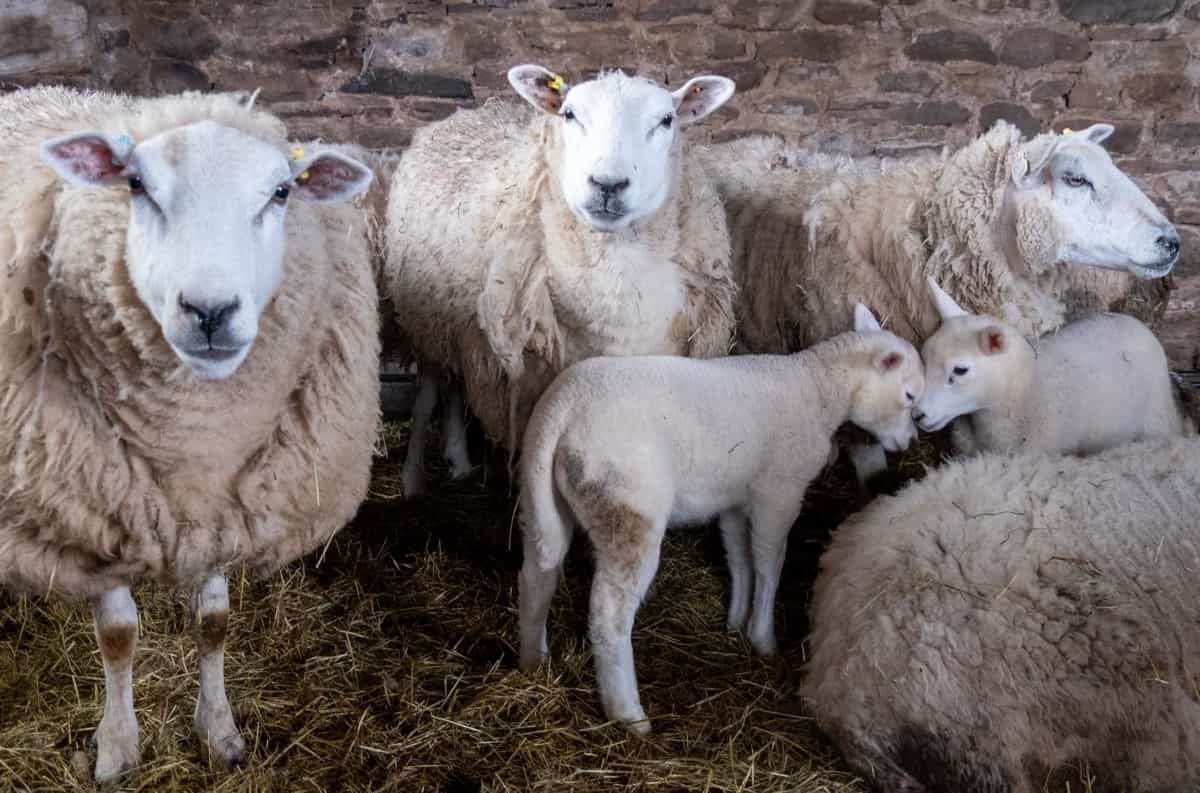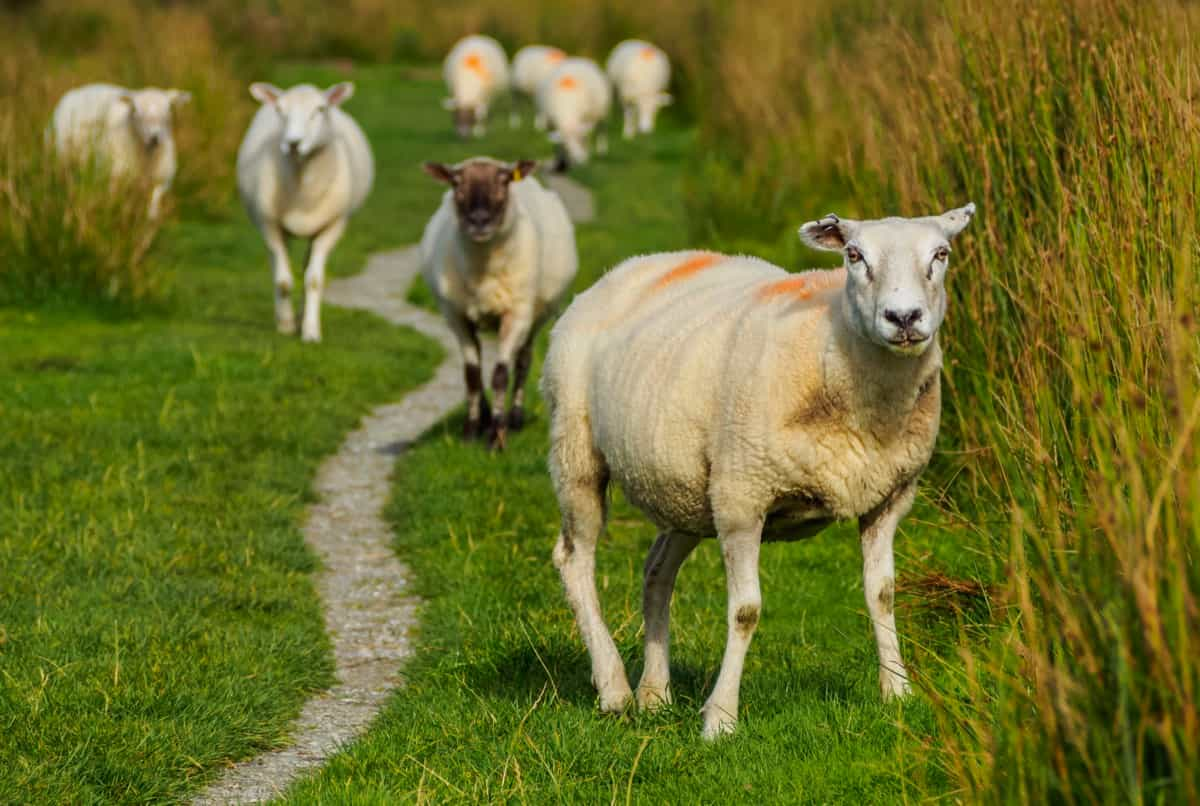Raising Lleyn sheep comes with a plethora of benefits that make them an attractive choice for farmers. These white-faced beauties are known for their exceptional maternal instincts, making them excellent mothers to their lambs. Their calm nature also makes handling and management easier on the farm.

History of the Lleyn Breed
Origin of Lleyn Sheep
The Lleyn sheep, hailing from the Llŷn peninsula in Wales, boasts a rich history dating back to its origins. Originally bred for their prolificacy and maternal qualities, these compact ewes have evolved into a prized breed known for their gentle nature. Additionally, their adaptability to various grazing conditions makes them suitable for both upland and lowland environments.
Physical Appearance and Breed Standards
With a distinctive white face and sturdy build, Lleyn sheep adhere to strict breed standards that emphasize their maternal instincts and efficient meat production capabilities. Their average body weight ranges between 65-75 kg for ewes and 85-90 kg for rams, making them versatile for both upland and lowland grazing environments.
This unique breed is highly regarded not only for its high milk production but also for its premium quality white wool. The combination of excellent mothering skills, docile temperament, and adaptability to various grazing conditions makes the Lleyn sheep a popular choice among farmers looking to enhance their flocks with superior genetics.
Key Characteristics of Lleyn Sheep
Behavioral Traits and Social Structure
Lleyn sheep are known for their gentle and calm demeanor, making them easy to handle and manage on the farm. Their social structure is based on a hierarchy within the flock, with dominant individuals leading the group while others follow suit.
Physical Attributes Unique to Lleyn Sheep
Lleyn sheep have a distinct white face and medium-sized frame that sets them apart from other breeds. Their strong legs enable them to navigate various terrains with ease, whether in upland or lowland grazing environments. The unique feature of Lleyn sheep is their exceptional maternal instincts. Ewes display excellent mothering skills, ensuring the well-being of their offspring from birth to weaning. The characteristics of Lleyn sheep make them valuable in breeding programs focused on improving lambing rates and overall productivity.
In case you missed it: Guide to Raising Poll Dorset Sheep: Facts, Profile, Characteristics, Uses, and Care

Breeding Practices and Genetics
Strategies for Selective Breeding
Selective Lleyn sheep breeding allows farmers to enhance desirable traits in their flock, such as prolificacy and mothering abilities. By carefully choosing which animals to breed together based on their genetic makeup, farmers can work towards improving the overall quality of their herd.
Genetic Health and Diversity Management
Genetic health and diversity management are also crucial aspects of successful breeding practices for Lleyn sheep. Maintaining a diverse gene pool helps prevent inbreeding and reduces the risk of genetic disorders within the flock. Regular health checks and monitoring ensure that the sheep are healthy and thriving, further contributing to sustainable breeding practices.
By implementing effective strategies for selective breeding and managing genetic health and diversity, farmers can work towards developing a strong and resilient flock of Lleyn sheep that excel in both productivity and overall well-being on the farm.
Ideal Habitat and Environmental Requirements
Suitable Climatic Conditions for Lleyn Sheep
Lleyn sheep thrive in a moderate climate with good ventilation and shelter. They are adaptable to various conditions but prefer mild temperatures. Providing adequate shade during hot summers and protection from harsh winds is essential for their well-being. Ensuring proper space per ewe is crucial to prevent overcrowding, which can lead to disease spread. Lleyn sheep enjoy grazing on pasture, so having ample grazing land is beneficial for their diet and overall health.
Shelter and Space Needs for Optimal Health
A well-ventilated barn or shed will protect the flock from extreme weather conditions like heavy rain or snow. Adequate bedding helps keep them comfortable and prevents hoof issues. Producing an environment that mimics their natural habitat ensures that Lleyn sheep remain healthy and content. By prioritizing their environmental needs, you can promote optimal growth and productivity within your flock.
Nutrition and Feeding Guidelines
Essential Dietary Needs of Lleyn Sheep
These sheep require a balanced diet rich in fiber, protein, vitamins, and minerals to thrive. Implementing an effective Lleyn sheep feeding guide ensures their health and productivity. Access to clean water at all times is also vital for proper digestion and hydration. Monitoring their food intake helps prevent overeating or deficiencies.
In case you missed it: Ultimate Guide to Bighorn Sheep: Characteristics, Diet, Lifespan, Breeding, and Lifecycle

Implementing Effective Feeding Programs
Grass and good-quality hay are staples in their diet, supplemented with grain if needed. During breeding seasons or periods of high energy demand, adjusting feed rations accordingly supports optimal performance. Regularly assessing body condition scores aids in fine-tuning feeding plans as needed. Consulting with a veterinarian or nutritionist can offer valuable insights into tailoring diets specific to your flock’s needs. By prioritizing proper nutrition and implementing sound feeding practices, you set your Lleyn sheep up for success on your farm.
Health Management and Preventative Care
Common Health Issues in Lleyn Sheep
Like any other livestock, these sheep can be susceptible to common health issues that need to be managed effectively. Common health issues in Lleyn sheep may include parasitic infections like worms, foot rot, and respiratory illnesses. Regular vaccination schedules and routine health checks are essential for preventing these issues from escalating.
Vaccination and Routine Health Checks
Vaccinations play a major role in protecting the herd from diseases such as clostridial infections and contagious ecthyma. Working closely with a veterinarian to establish an appropriate vaccination plan is key to maintaining the overall health of your flock. Routine Lleyn sheep health management checks allow you to monitor the condition of each sheep, identify any potential problems early on, and take necessary actions promptly. Early detection can significantly impact the outcomes of treatment and prevent further spread of diseases within the flock.
Wool and Fleece Production
Characteristics of Lleyn Fleece
The Lleyn sheep is well-regarded for its high-quality fleece, which has fine fibers and a soft texture. Their wool is highly sought after by crafters for its excellent spinning qualities.
Harvesting and Processing Wool for Market
When it comes to harvesting the wool from Lleyn sheep, timing is crucial. Shearing should be done once a year in spring before the weather gets too warm. Processing the wool involves multiple steps, such as cleaning, carding, spinning, and possibly dyeing. The result is a beautiful yarn that can be used for knitting, weaving, or felting projects. Lleyn fleece is known for its natural white color, making it versatile for various dyeing techniques.
Meat Production and Quality
Raising Lleyn Sheep for Meat
Raising Lleyn sheep for meat production involves careful breeding and nutrition practices to ensure high-quality meat. The lean and flavorful meat from Lleyn sheep is sought after by discerning consumers looking for a premium product.
Enhancing Meat Quality and Marketing Strategies
To enhance the meat quality, it is essential to provide a stress-free environment, proper nutrition, and regular health checks. Marketing approaches play a main role in promoting Lleyn lamb as a top choice in the market. Emphasizing the breed’s superior qualities, such as tenderness, taste, and sustainable farming practices, can appeal to health-conscious consumers seeking ethically sourced products. Collaborating with local markets, restaurants, or online platforms can help reach an audience interested in premium lamb products.
Sustainable Farming Practices with Lleyn Sheep
Environmental Sustainability in Sheep Farming
Lleyn sheep play a crucial role in promoting environmental sustainability within the agriculture industry. By raising Lleyn sheep on your farm, you are not only contributing to the conservation of this unique breed but also supporting eco-friendly agricultural methods.
Their adaptability to various climatic conditions and their efficient conversion of feed into meat make them an ideal choice for farmers looking to minimize their environmental impact environmental impact of Lleyn sheep. Additionally, their hardiness and low maintenance requirements further enhance their suitability for sustainable Lleyn sheep farming practices.
Role of Lleyn Sheep in Eco-Friendly Agriculture
By implementing responsible breeding strategies, prioritizing health management, and focusing on both wool and meat production quality, farmers can ensure that Lleyn sheep contribute positively to the overall sustainability of their operations. In essence, integrating Lleyn sheep into your farming practices is a step towards making a more environmentally conscious agricultural system that benefits both the farmer and the planet.
In case you missed it: Ultimate Guide to Raising Katahdin Sheep: Farming Facts, Breed Profile, Uses, and Care

Conclusion
Raising Lleyn sheep is crucial for sustainable farming practices. These hardy and adaptable animals play a significant role in eco-friendly agriculture by thriving in various environmental conditions. Raising Lleyn sheep is a deliberate choice for many farmers seeking efficiency and quality in their livestock.
Note: The images presented in this post are intended solely for representation purposes. The images are meant to serve as visual aids and should not be relied upon as accurate representations of their real-life counterparts.
- Feed Your Flock for Less: Top 10 Tips to Save on Chicken Feed
- Ultimate Guide to Ossabaw Island Hog: Breeding, Raising, Diet, and Care
- Hatching Answers: The Top 10 Reasons Your Chickens Aren’t Laying Eggs
- Eggs and Economics: Breaking Down the Cost of Raising Backyard Chickens
- Defend Your Greens: Proven Methods to Keep Iguanas Out of Your Garden
- Ultimate Guide to Cinnamon Queen Chicken: A Comprehensive Guide for Beginners
- Ultimate Guide to California Tan Chicken: Breeding, Raising, Diet, Egg-Production and Care
- Ultimate Guide to Marsh Daisy Chicken: Breeding, Raising, Diet, and Care
- 10 Types of Chicken Farming Businesses You Can Start for Profits